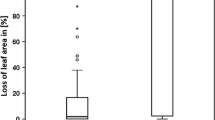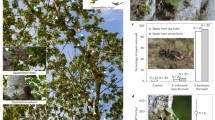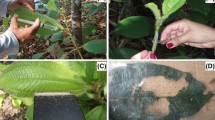Summary
The hypothesis that ants (Pheidole minutula) associated with the myrmecophytic melastome Maieta guianensis defend their host-plant against herbivores was investigated in a site near Manaus, Amazonas, Brazil. M. guianensis is a small shrub that produces leaf pouches as ant domatia. Plants whose ants were experimentally removed suffered a significant increase in leaf damage compared with control plants (ants maintained). Ants patrol the young and mature leaves of Maieta with the same intensity, presumably since leaves of both ages are equally susceptible to herbivore attack. The elimination of the associated ant colony, and consequent increase in herbivory, resulted in reduced plant fitness. Fruit production was 45 times greater in plants with ants than in plants without ants 1 year after ant removal.
Similar content being viewed by others
References
Beattie AJ (1985) The evolutionary ecology of ant-plant mutualisms. Cambridge University Press, Cambridge
Benson WW (1985) Amazon ant-plants. In: Prance GT, Lovejoy TE (eds) Amazonia. Pergamon Press, Oxford, 239–266
Davidson DW, Snelling RR, Longino JT (1989) Competition among ants for myrmecophytes and the significance of plant trichomes. Biotropica 21:64–73
Downhower JF (1975) The distribution of ants on Cecropia leaves. Biotropica 7:59–62
Guillaumet JL (1987) Some structural and floristic aspects of the forest. Experientia 43:241–251
Huxley C (1986) Evolution of benevolent ant-plant relationships. In: Juniper B, Southwood TRE (eds) Insects and the plant surface Edward Arnold, London, pp 257–282
Janzen DH (1972) Protection of Barteria (Passifloraceae) by Pachysima ants in a Nigerian rain forest. Ecology 53:885–892
Janzen DH (1974) Epiphytic myrmecophytes in Sarawak: Mutualism through the feeding of plants by ants. Biotropica 6:237–259
Letourneau DK (1983) Passive aggression: An alternative hypothesis for the Piper-Pheidole association. Oecologia 60:122–126
McKey D (1984) Interaction of the ant-plant Leonardoxa africana (Caesalpinaceae) with its obligate inhabitants in a rainforest in Cameroon. Biotropica 16:81–99
O'Dowd DJ (1982) Pearl bodies as ant food: an ecological role for some leaf emergences of tropical plants. Biotropica 14:40–49
Ribeiro MNG (1976) Aspectos climatológicos de Manaus. Acta Amazonica 6:229–233
Schemske DW (1980) The evolutionary significance of extrafloral nectar production by Costus woodsonii (Zingerberaceae): an experimental analysis of ant protection. J Ecol 68:959–967
Author information
Authors and Affiliations
Rights and permissions
About this article
Cite this article
Vasconcelos, H.L. Mutualism between Maieta guianensis Aubl., a myrmecophytic melastome, and one of its ant inhabitants: ant protection against insect herbivores. Oecologia 87, 295–298 (1991). https://doi.org/10.1007/BF00325269
Received:
Accepted:
Issue Date:
DOI: https://doi.org/10.1007/BF00325269




